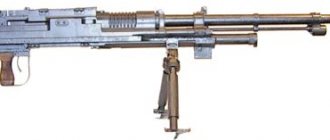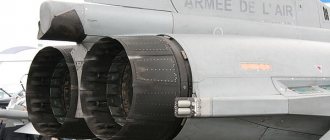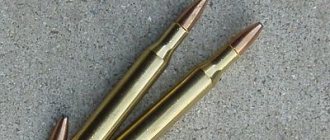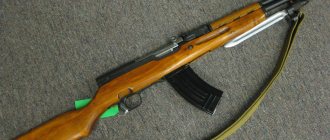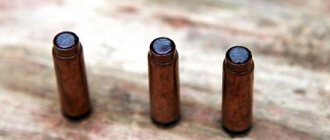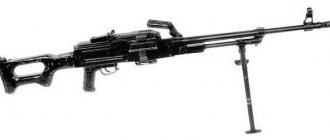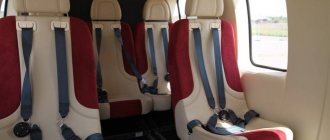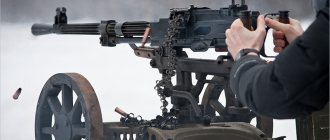HK MP7
Personal defense weapon
(English: Personal defense weapon, PDW) is a term used in Western countries that denotes a light and compact weapon intended for arming military personnel of the so-called “second line” (crews of combat vehicles, artillery crews and others), who are not entitled to "full-size" weapons, but which may require more firepower than pistols can provide.[1]
In accordance with GOST 28653-90 used in Russia “Small arms. Terms and definitions”, most representatives of this type of weapon should be classified as submachine guns or automatic pistols (depending on the presence/absence of a shoulder rest or an additional front handle).[2] Also, a similar niche (weapons for the crews of combat vehicles and crews of artillery pieces) should have been occupied by an assault rifle.[3]
From left to right: 4.6x30mm, 5.7x28mm and .30 Carbine cartridges.
For these purposes, self-loading or automatic pistols, as well as small-sized submachine guns, were traditionally used, however, due to the proliferation of personal protective equipment (helmets and body armor), it was necessary to create weapons with greater penetrating power, which, however, did not impose additional restrictions on soldiers and did not restrict movement in the cramped back of a combat vehicle.
To solve such a problem, first of all, it was necessary to create a completely new ammunition, combining the low mass and recoil of a pistol cartridge with the advantageous ballistics and penetrating ability of an intermediate one. Examples of such cartridges include the German 4.6×30 mm and the Belgian 5.7×28 mm, on the basis of which some of the most famous PDW samples were developed - HK MP7 and FN P90, capable of hitting opponents in Kevlar body armor at ranges up to 200 m.[1][4] Thus, a modern PDW often surpasses a conventional submachine gun in terms of armor penetration and effective firing range with similar (or even smaller) weight and dimensions.
Thus, weapons of the PDW class have sufficient armor-piercing power, rate of fire and ergonomics, but are often inferior in shot power to other classes of weapons due to the low weight of the bullet.
It is worth noting, however, that this concept is not completely new: even during World War II, the Americans rearmed second-line military personnel from self-loading pistols to M1 Carbine carbines, although for a slightly different reason: personal protective equipment was underdeveloped at that time, but this carbine significantly increased the soldier’s efficiency in battle, and also, no less important, required much less time (and therefore financial) costs for shooting training than a pistol.[5]
Despite the initial focus, in practice, weapons created according to this concept are most popular among various special units due to their small dimensions and weight, which do not interfere in combat conditions in close quarters, high rate of fire and capacious magazines, allowing for the creation of a high density of fire, as well as penetrating the ability of bullets, leaving no chance for opponents wearing light Kevlar body armor.[1][4]
In the USSR in the 1970s, steps were taken in a similar direction (development work "Modern"), but unlike the West, Soviet gunsmiths concentrated on creating a small-sized machine gun chambered for a standard intermediate cartridge. This, combined with the widespread unification of the winning model in the competition - AKS74U - with the Kalashnikov assault rifle already in service, led to the fact that this attempt to create an effective self-defense weapon for military personnel of technical branches of the military and auxiliary units cannot be considered 100% successful: AKS74U turned out to be for this role it was too heavy and bulky, and the effectiveness of automatic fire from it was relatively low due to the strong dispersion of bullets. Similar problems were typical for the small-sized HK-53 assault rifle developed in Germany at approximately the same time and according to a similar ideology (based on the HK-33 assault rifle/assault rifle), which indicates the fundamental shortcomings of such a concept. However, one cannot equate a small-sized assault rifle with a PDW - the former are usually somewhat more powerful and more accurate when it comes to a single shot.
However, later, already in Russia, another small-sized machine gun was developed - 9A-91, now designed for the use of cartridges of the SP5 - SP6 type, which were somewhat weakened compared to machine guns (9 × 39 mm, muzzle energy of about 700 J) , which makes it an interesting example, quite close to the PDW concept. At the same time, due to the use of special ammunition, it lost one of the main advantages of a small-sized machine gun - cartridge unification with the main model of army small arms.
At a distance of 100 m, 9A-91 provides penetration of 8-mm steel sheet or body armor up to the 3rd class of protection. At the same time, the heavy bullet retains high kinetic energy much longer, which makes the 9A-91 a much more effective weapon than traditional SMGs chambered for 9 mm Para, such as the MP5K-PDW (at close muzzle energy, at a distance of 100 m the difference in bullet energy of the cartridge 9 mm Para and the 9x39 mm cartridge is already 52% in favor of the latter).
Among Russian weapons, submachine guns are also intended for similar purposes: PP-2000, which uses special armor-piercing versions of 9x19 mm Parabellum cartridges - 7N31 and 7N21, AEK-919K "Kashtan" (intended to arm crews of combat vehicles and pilots, but uses conventional pistol cartridge 9x18 mm PM, which is significantly inferior to the above-mentioned ammunition in terms of armor penetration)[6][7] and SR-2 "Veresk" (not positioned as a self-defense weapon, but is small in size and uses 9x21 mm armor-piercing cartridges).[ 8]
Modern personal defense weapons
- FN P90 (5.7×28 mm)
- HK MP7 (4.6x30mm)
- PP-2000 (9.0×19 mm) - PDW with 7N31 armor-piercing bullet.
- Colt MARS (5.56x30mm MARS)
- Knight's Armament Company PDW (6x35mm KAC)
- Magpul PDR (5.56x45mm) - production canceled at the prototype stage.
- Type 05 / QCW-05 (5.8×21 mm)
- Saab Bofors Dynamics CBJ-MS (6.5×25 CBJ-MS)
- ST Kinetics CPW (4.6x30mm, 5.7x28mm, 9x19mm)
- VBR-Belgium PDW (7.92×24 mm)
- INSAS MSMC (5.56x30mm MINSAS)
- Chang Feng (5.8x21mm DAP92-9)
Pistols chambered for POS[edit | edit code]
- FN Five-seven (5.7x28 mm) - kit for FN P90.
- GSh-18 (9×19 mm) - kit for PP-2000 (POS with 7N31 armor-piercing bullet).
- HK UCP (4.6x30mm) - production canceled at prototype stage.
- QSZ-92 (5.8x21mm DAP92-9)
- VBR-Belgium CQBW (4.6x30mm, 5.7x28mm, 7.92x24mm)
- MP-443 "Rook" (9x19 mm) - POS with a 7N31 armor-piercing bullet.
- SR-1 "Vector" (9x21 mm) - kit for SR-2 "Veresk".
- Mauser K96 (7.63x25 mm) is the world's first POS pistol.
Main modifications of the KV-1 tank
HF arr. 1939 (U-0) - an experimental heavy tank, designed at SKB-2 LKZ (Leningrad) under the leadership of Zh.Ya. Kotin in 1938-1939. Subsequently, N.L. was appointed the leading designer of the KV tank. Dukhova. From November 1939 to January 1940, the tank underwent military tests in the Karelian Isthmus area, where it was actively used in battles. After returning to the LKZ, it served as the basis for the design of a pre-production model of the tank, designated U-2, which underwent military tests on the Karelian Isthmus in February-March 1939.
The U-0 differed from the serial tank produced in 1940:
— The tank’s crew consisted of four people, located: the tank commander - in the turret to the right of the gun, the driver - in the control compartment along the axis of symmetry of the tank hull, the gunner - in the turret to the left of the gun, the loader-radio operator - in the turret to the right of the breech gun parts. — A 45-mm cannon was installed in the tank’s turret mask installation to the right of the main gun. — The main armament of the tank consisted of one 76.2-mm L-11 cannon, one 45-mm cannon mod. 1934, two 7.62-mm DT machine guns, one aft, mounted in a ball mount in the rear niche of the turret, and one anti-aircraft, mounted on the P-40 anti-aircraft turret.
The tank's ammunition load was 118 76.2 mm and 50 45 mm rounds for cannons, 1008 rounds for machine guns. Before being sent to the Karelian Isthmus, in November 1939, the 45-mm cannon was replaced with a 7.62-mm DT machine gun.
Read: Su-24 aircraft
— The power plant used a V-2 diesel engine with a power of 500 hp. — The transmission used the main clutch from the T-28 tank. — The chassis used tracks with tracks 660 millimeters wide. — For external communications, the tank was equipped with a short-wave telephone and telegraph radio station 71-TK-1, located in the tank turret. Internal communication was provided by the TPU-3 tank intercom.
KV-1 arr. 1939 (U-7) - serial heavy tank, designed under the leadership of N.L. Dukhov in 1940 based on the design of the pre-production U-2 tank. In May-June 1940, under the designation U-7, the tank passed state tests. During serial production at LKZ (Leningrad - 407 tanks) and ChKZ (Chelyabinsk - from January 1941 - 25 tanks) from April 1940 to July 1941, 432 KV-1 tanks were manufactured.
During serial production, the tank was improved:
— Since July 1940, a new “faceted” riveted-welded tower with a wall thickness of 75 millimeters was introduced. - Since October 1940, two additional 7.62-mm DT machine guns were introduced: one course gun - in a ball mount in the frontal part of the hull on the left, the second anti-aircraft gun - on the P-40 anti-aircraft machine gun turret. — In January 1941, after the release of three tanks with the L-11 cannon, the 76.2 mm F-32 cannon was introduced. For aiming when firing from a cannon and coaxial machine gun, they began to use the PT-8 periscope sight and the TOD-8 telescopic sight. The tank's ammunition load increased to 114 rounds for the cannon. — Since June 1, 1941, the thickness of the armor plates of the frontal part of the hull has been increased due to the welding of overhead 20 mm armor plates. To protect the turret ring, armor strips up to 80 millimeters high and 40 millimeters thick began to be welded onto the roof of the hull.
KV-1 arr. 1941 - serial heavy tank, designed at SKB-2 LKZ under the leadership of N.L. Dukhov (lead engineer N.V. Halkiopov) based on the design of the KV-1 tank mod. 1940. During serial production at LKZ (Leningrad, until October 19, 1941 - 444 tanks) and ChKZ (Chelyabinsk - until August 1942 - 2286 tanks) from July 1941 to August 1942, 2732 KV tanks were manufactured -1 arr. 1941
From the KV-1 tank mod. 1940 it was different:
— Since July 1941, a simplified welded reinforced turret with reduced dimensions was introduced. — In July-August 1941, ChKZ mastered the production of cast road wheels without internal shock absorption and support rollers without rubber tires. - Since October 1941, instead of the F-32 cannon, a 76.2-mm ZiS-5 cannon was introduced, for aiming when firing from which telescopic sights TMFD-7, 9T-7, 10T-7, 10T-13 and periscope sights PT4- were used 7, PT4-13. — Since November 1941, a cast turret with a thickness of the frontal part of 85-90 millimeters and walls of 87 millimeters was introduced. — Since December 1941, they began installing a 10P telephone and telegraph radio station on the tank. — Since the end of 1941, instead of two SMT-4628 starters, they began to install one ST-700 starter.
KV-8 is a serial heavy flamethrower tank, designed at SKB-2 ChKZ under the leadership of Zh.Ya. Kotin on the basis of the experimental flamethrower tank “Object 228” in January-February 1942. The tank was adopted by the Red Army on January 6, 1942. In February 1942, the KV-8 successfully passed field tests. During serial production at ChKZ (Chelyabinsk) from February to August 1942, 102 tanks were manufactured.
Read: Yak-24 helicopter - “flying carriage”
From the serial tank KV-1 mod. 1941 it was different:
— The loader was excluded from the tank crew (4 people). — The mask installation of the main weapons is adapted for the twin installation of a flamethrower, a cannon and a machine gun. — The main armament of the tank consisted of one automatic powder flamethrower ATO-41, one 45-mm cannon mod. 1932/38 (disguised with a special casing as a 76.2 mm F-32 cannon, and four 7.62 mm DT machine guns (identical to the machine gun armament of the KV-1 tank model 1941), for aiming When flamethrowing and firing from a cannon and coaxial machine gun, a PT4 periscope sight and a TMF telescopic sight were used.The tank's ammunition load was 63 rounds (570 liters of fire mixture for 57 fire shots) for the flamethrower, 116 rounds for the cannon, 2772 rounds (44 disks) for machine guns.
KV-9 (“Object 229”) is an experimental heavy tank designed by SKB-2 ChKZ under the leadership of A.S. Ermolaev (lead engineer A.S. Shneideman) based on the design of the KV-1 tank mod. 1941 at the end of 1941. A prototype of the tank, manufactured at ChKZ in January 1942, successfully passed field tests in February. Due to the deteriorating reliability of the tank's transmission, armament with the KV howitzer was abandoned.
From the serial tank KV-1 mod. 1941 it was different:
— In the frontal part of the cast turret, the design is identical to the KV-1 turret mod. 1941, a larger embrasure was installed to accommodate the mask installation of a 122-mm howitzer, which housed a coaxial machine gun on the right. Thickness of the turret armor: frontal part – 115 millimeters, walls – 95 millimeters. — The main armament of the tank consisted of one 122-mm howitzer U-11 (M-30), for aiming when firing from which a PT periscopic sight and a TMFD telescopic sight were used. The tank's ammunition load was 48 rounds for the howitzer and 1,953 rounds (31 discs) for the machine gun. — The power plant used an uprated V-2K diesel engine with a power of 650 hp. — The chassis of the tank used tracks with tracks 608 millimeters wide. — For external communications, a short-wave telephone and telegraph radio station 10P was installed on the tank. Internal communication was provided by the TPU-4-bis tank intercom.
KV-12 (“Object 232”) is an experimental chemical tank designed at SKB-2 ChKZ under the leadership of S.V. Fedorenko and pilot plant No. 100 under the leadership of Zh.Ya. Kotin based on the KV-1 tank mod. 1941 to May 1942. The manufactured prototype of the tank passed tests, but was not accepted for service.
From the serial tank KV-1 mod. In 1941, it was notable for the installation of special equipment for contamination, decontamination of the area and setting up smoke screens.
KV-1K is an experimental heavy tank manufactured at Experimental Plant No. 100 (Chelyabinsk) under the leadership of A.S. Ermolaev according to the project of V.I. Alexandrov in June 1942. From August 7 to August 31, 1942, the tank successfully passed field tests, but did not receive a development project. From the serial tank KV-1 mod. 1941, it was distinguished by the installation in the rear part of the hull, on mud wings, of four guns (launchers) of the short artillery missile system KARST-1. The gun was a box-shaped structure made of armor plates 10 and 30 millimeters thick, in which two guides for 132-mm M-13 rockets were mounted. The front guns had an installation angle of +3°, the rear ones - +4°.
Description of the design of the KV-1 tank of the 1939 model
The KV-1 tank had a classic general layout with the control compartment located in the bow of the hull, the fighting compartment in the middle part of the hull, and the turret mounted on top, and the engine and transmission compartments in the rear of the hull. The tank's crew consisted of five people, located: the tank commander (loader) - in the turret to the right of the gun, the driver - in the control compartment along the longitudinal axis of the hull, the gunner (artilleryman) - in the turret to the left of the gun, the radio operator - in control compartment on the right side of the hull, junior mechanic-driver (machine gunner of the rear machine gun) - in the turret to the left of the breech of the gun.
The armored body of the tank was welded from rolled armor plates with a thickness of 75, 40, 30 and 20 millimeters. The armor protection is equally strong (armor plates with a thickness other than 75 mm were used only for horizontal armoring of the vehicle), and is projectile-resistant. The armor plates of the frontal part of the vehicle were installed at rational angles of inclination. The side of the hull was made of one vertical armor plate, which had six holes for the passage of the balancer axes, six brackets with platforms for attaching rubber stops that limited the upward movement of the balancers, as well as holes for attaching three brackets for the support rollers. In the upper part of the hull along the sides, mud wings are mounted on brackets, on which boxes with tools and transportable spare parts are mounted. The rear of the hull consisted of upper (60 mm) and lower (75 mm) armor plates, between which there was a pocket for air outlet. Two towing eyes were welded to the lower stern plate. The roof of the tank hull consisted of three parts: the roof over the fighting compartment, the roof over the engine compartment and the roof over the transmission compartment. The roof over the fighting compartment was made of 40 mm armor plate, in which there was a round cutout for installing the lower shoulder strap of the turret support and the driver's hatch. On the removable armored cover of the engine compartment, 30 millimeters thick, there was a hatch for access to the engine, two exhaust pipes, two openings for the entrance of cooling air and a hatch for filling water into the cooling system filler tank. There were two hatches in the roof of the transmission compartment, intended for access to the transmission mechanisms. The bottom of the hull was butt welded from two armor plates. In the front part of the hull it had a large armor thickness of 40 millimeters, in the rear - 30 millimeters. In the front part of the bottom, behind the driver's seat, there was a spare (emergency) hatch. In the rear part of the bottom there were four holes for draining oil and water and one sub-engine hatch.
The tank's turret, with an armor thickness of 75 millimeters, is riveted-welded, faceted, close to a rectangular shape in plan, with a rear niche. The front part of the turret with the embrasure for the gun, formed by the intersection of four spheres, was cast separately and welded with the rest of the turret parts. The gun mantlet was a cylindrical segment of bent rolled armor plate and had three holes - for a cannon, a coaxial machine gun and a sight. The sides of the turret had viewing slots with glass blocks, one on each side, and under them there were holes for firing from a revolver. The holes were closed with conical armor plugs. There was a round entrance hatch in the roof of the tower. In front of the turret roof there were armored caps for the PT-6 sight and the PTK tank commander panorama, and between them there was an armored cap for the ventilation hatch. Armored visors of mirrored viewing devices were placed on the sides and in the rear part of the turret roof. The tank's turret was mounted on a shoulder strap with a diameter of 1,535 millimeters in the armored roof of the fighting compartment and secured with grips. Inside, the turret shoulder straps were marked in thousandths for firing from closed positions.
Read: Tank T-10 M
The main armament of the tank consisted of one 76.2 mm cannon mod. 1938/39 L-11 and two 7.62-mm DT machine guns, one coaxial with a cannon, the second aft, mounted in a ball mount in the rear niche of the tank turret. For aiming when firing from a cannon and coaxial machine gun, a TOD-6 telescopic sight and a PT-6 periscopic panoramic sight were used. The tank's ammunition load was 111 rounds for the cannon and 3,024 rounds (48 discs) for machine guns.
The tank's power plant used a twelve-cylinder, four-stroke, compressorless, liquid-cooled V-2K diesel engine with a power of 600 hp. The mechanical transmission consisted of a multi-disc main ferrodo-on-steel dry friction clutch, a five-speed twin-shaft gearbox providing five forward gears and one reverse gear, multi-disc steel-on-steel dry friction side clutches with floating band brakes and two planetary double-row final drives.
The chassis of the tank, in relation to one side, consisted of one front-mounted dual-slope idler wheel with a screw-type track tensioning mechanism, six dual-slope road wheels with internal shock absorption, three rubber-tired support rollers, one rear-mounted drive wheel with replaceable pinion gears and one small-link caterpillar, consisting of 87-90 stamped steel tracks with a width of 700 millimeters. The electrical equipment of the tank was made according to a single-wire circuit with a voltage of 24 V.
For external communications, the tank was equipped with a short-wave telephone and telegraph radio station 71-TK-3, located in the bow of the tank hull on the left side. Internal communication was provided by the TPU-4-bis tank intercom.


